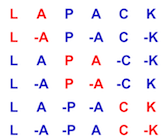 |
LAPACK
3.9.0
LAPACK: Linear Algebra PACKage
|
 |
LAPACK
3.9.0
LAPACK: Linear Algebra PACKage
|
| subroutine zlamtsqr | ( | character | SIDE, |
| character | TRANS, | ||
| integer | M, | ||
| integer | N, | ||
| integer | K, | ||
| integer | MB, | ||
| integer | NB, | ||
| complex*16, dimension( lda, * ) | A, | ||
| integer | LDA, | ||
| complex*16, dimension( ldt, * ) | T, | ||
| integer | LDT, | ||
| complex*16, dimension(ldc, * ) | C, | ||
| integer | LDC, | ||
| complex*16, dimension( * ) | WORK, | ||
| integer | LWORK, | ||
| integer | INFO | ||
| ) |
ZLAMTSQR
ZLAMTSQR overwrites the general complex M-by-N matrix C with
SIDE = 'L' SIDE = 'R'
TRANS = 'N': Q * C C * Q
TRANS = 'C': Q**H * C C * Q**H
where Q is a real orthogonal matrix defined as the product
of blocked elementary reflectors computed by tall skinny
QR factorization (ZLATSQR) | [in] | SIDE | SIDE is CHARACTER*1
= 'L': apply Q or Q**H from the Left;
= 'R': apply Q or Q**H from the Right. |
| [in] | TRANS | TRANS is CHARACTER*1
= 'N': No transpose, apply Q;
= 'C': Conjugate Transpose, apply Q**H. |
| [in] | M | M is INTEGER
The number of rows of the matrix A. M >=0. |
| [in] | N | N is INTEGER
The number of columns of the matrix C. M >= N >= 0. |
| [in] | K | K is INTEGER
The number of elementary reflectors whose product defines
the matrix Q.
N >= K >= 0; |
| [in] | MB | MB is INTEGER
The block size to be used in the blocked QR.
MB > N. (must be the same as DLATSQR) |
| [in] | NB | NB is INTEGER
The column block size to be used in the blocked QR.
N >= NB >= 1. |
| [in] | A | A is COMPLEX*16 array, dimension (LDA,K)
The i-th column must contain the vector which defines the
blockedelementary reflector H(i), for i = 1,2,...,k, as
returned by DLATSQR in the first k columns of
its array argument A. |
| [in] | LDA | LDA is INTEGER
The leading dimension of the array A.
If SIDE = 'L', LDA >= max(1,M);
if SIDE = 'R', LDA >= max(1,N). |
| [in] | T | T is COMPLEX*16 array, dimension
( N * Number of blocks(CEIL(M-K/MB-K)),
The blocked upper triangular block reflectors stored in compact form
as a sequence of upper triangular blocks. See below
for further details. |
| [in] | LDT | LDT is INTEGER
The leading dimension of the array T. LDT >= NB. |
| [in,out] | C | C is COMPLEX*16 array, dimension (LDC,N)
On entry, the M-by-N matrix C.
On exit, C is overwritten by Q*C or Q**H*C or C*Q**H or C*Q. |
| [in] | LDC | LDC is INTEGER
The leading dimension of the array C. LDC >= max(1,M). |
| [out] | WORK | (workspace) COMPLEX*16 array, dimension (MAX(1,LWORK)) |
| [in] | LWORK | LWORK is INTEGER
The dimension of the array WORK.
If SIDE = 'L', LWORK >= max(1,N)*NB;
if SIDE = 'R', LWORK >= max(1,MB)*NB.
If LWORK = -1, then a workspace query is assumed; the routine
only calculates the optimal size of the WORK array, returns
this value as the first entry of the WORK array, and no error
message related to LWORK is issued by XERBLA. |
| [out] | INFO | INFO is INTEGER
= 0: successful exit
< 0: if INFO = -i, the i-th argument had an illegal value |
Tall-Skinny QR (TSQR) performs QR by a sequence of orthogonal transformations,
representing Q as a product of other orthogonal matrices
Q = Q(1) * Q(2) * . . . * Q(k)
where each Q(i) zeros out subdiagonal entries of a block of MB rows of A:
Q(1) zeros out the subdiagonal entries of rows 1:MB of A
Q(2) zeros out the bottom MB-N rows of rows [1:N,MB+1:2*MB-N] of A
Q(3) zeros out the bottom MB-N rows of rows [1:N,2*MB-N+1:3*MB-2*N] of A
. . .
Q(1) is computed by GEQRT, which represents Q(1) by Householder vectors
stored under the diagonal of rows 1:MB of A, and by upper triangular
block reflectors, stored in array T(1:LDT,1:N).
For more information see Further Details in GEQRT.
Q(i) for i>1 is computed by TPQRT, which represents Q(i) by Householder vectors
stored in rows [(i-1)*(MB-N)+N+1:i*(MB-N)+N] of A, and by upper triangular
block reflectors, stored in array T(1:LDT,(i-1)*N+1:i*N).
The last Q(k) may use fewer rows.
For more information see Further Details in TPQRT.
For more details of the overall algorithm, see the description of
Sequential TSQR in Section 2.2 of [1].
[1] “Communication-Optimal Parallel and Sequential QR and LU Factorizations,”
J. Demmel, L. Grigori, M. Hoemmen, J. Langou,
SIAM J. Sci. Comput, vol. 34, no. 1, 2012 Definition at line 198 of file zlamtsqr.f.